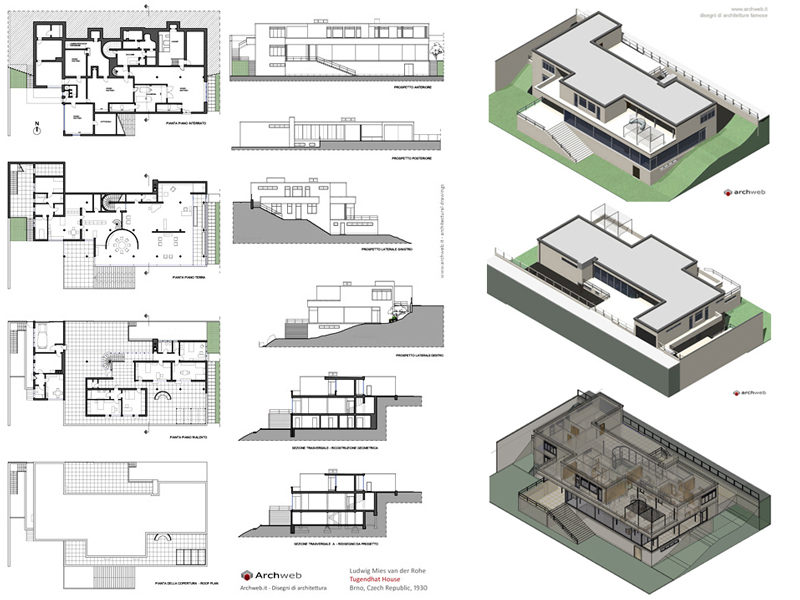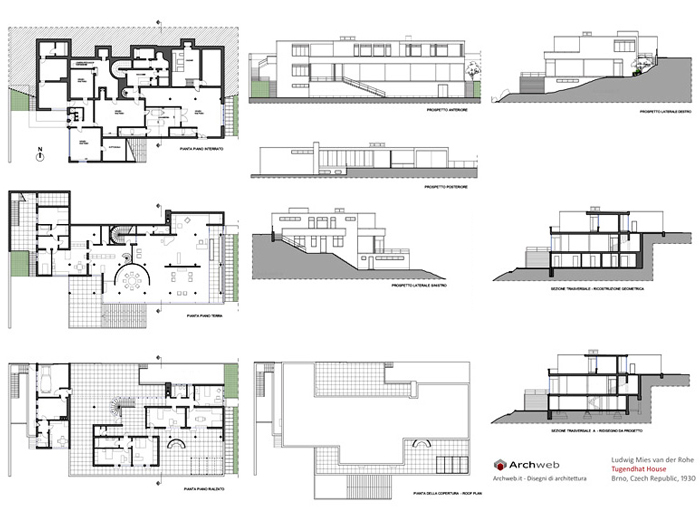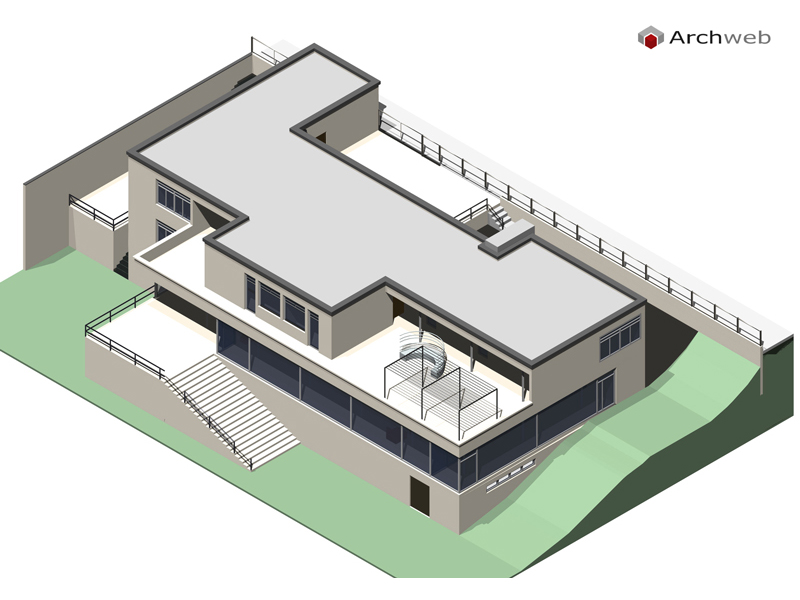Tugendhat House
Ludwig Mies van der Rohe – Brno, Czech Republic, 1930
Location
Brno, Repubblica Ceca
Year
1928 - 1930
Architect
L. Mies van der Rohe
Villa Tugendhat is a villa located in Brno in the Czech Republic and designed in the years 1928-30 by the German architect Ludwig Mies van der Rohe.
It is one of the most representative buildings of modern architecture. In 2002 the villa was inscribed on the prestigious list of UNESCO World Heritage Sites. The Tugendhat villa was commissioned by Grete and Fritz Tugendhat, a Jewish couple with the money of the wealthy family of textile companies from Brno. The couple met Mies van der Rohe in Berlin in 1927 and was already impressed with his plan for the house of Zehlendorf by Edward Fuchs. As a fan of spacious houses with simple shapes, Mies' free floor method was perfect for the taste of the Tugendhat; however, it was not their only choice, at first they found themselves facing the most important modern architect of Brno, Arnost Wiesner, but after visiting various projects of both, the Tugendhat couple chose Mies.

Mies visited the site in September 1928 and had already produced plans by December of the same year. He shared his project with the Tugendhat family on the occasion of the New Year and, with some minor changes, the new plans for the construction were drawn up. Mies has implemented his new functionalist concept of iron structure, eliminating the load-bearing internal walls and allowing more open and lighter spaces. The villa consisted of three levels (including the basement), with different floor plans and shapes, each connected differently to the sloping ground. The south-east and garden facades were completely floor-to-ceiling glazed. The Tugendhat villa was a rather large house, complete with two bedrooms for children and for the nanny and a bathroom that they shared in the front of the house, while the main bed and the bathroom were in the back and connected to the terrace. The project also included spaces for staff and the housekeeper.
The villa was exceptionally expensive for its time considering the sumptuous materials, the abnormal construction methods and the extraordinary new heating and cooling technologies. The house was very advanced for a private residence, and while the total cost has never been known, the estimates are close to five million Czech crowns, that is, in 1930 with that figure at least 30 small family houses could have been built. Brno was already a center of modern architecture for Czechoslovakia in the 1920s, and Villa Tugendhat was only best received with moderate praise among the avant-garde of the time. Many of the left wing elites in the art world have seen the new home as snobbish and exaggerated by its lush interior and furnishings design. Mies has designed all the furniture in the house and has precisely chosen the positioning of each piece and appliance. Although there were no works of art on the walls or decorations in or on the house, it was never seen naked or simple due to the rich materiality of the onyx and the rare tropical woods used throughout the house. The villa was built by building contractors from Brno, but the iron structure was built by Berlin entrepreneurs. The steel frame structure was unusual for homes at the time, but it brought with it many advantages that Mies had already experienced in his famous Barcelona pavilion: thinner walls, a free floor that could vary from floor to floor, large glass walls to open the rooms and connect them to the garden, etc. The minimal and balanced design has become a distinctive sign in Mies' residential creations. In 1938 the Tugendhat family left Czechoslovakia for Venezuela shortly before the Munich Agreement and never returned. The Nazi Gestapo installed apartments and offices in the abandoned house. During the Second World War, most of the windows were destroyed and the original furniture stolen during the air raids. The villa was used in 1992 for the formal signature that separated the country into the current Czech Republic and Slovakia, and since 1994 it has been open to the public as a museum. The heirs of Fritz and Grete Tugendhat presented the request for reinstatement of the villa in 2007, based on the laws in force on works of art confiscated during the Holocaust. Villa Tugendhat underwent a multi-million dollar reconstruction / restoration completed in 2012.
The villa was exceptionally expensive for its time considering the sumptuous materials, the abnormal construction methods and the extraordinary new heating and cooling technologies. The house was very advanced for a private residence, and while the total cost has never been known, the estimates are close to five million Czech crowns, that is, in 1930 with that figure at least 30 small family houses could have been built. Brno was already a center of modern architecture for Czechoslovakia in the 1920s, and Villa Tugendhat was only best received with moderate praise among the avant-garde of the time. Many of the left wing elites in the art world have seen the new home as snobbish and exaggerated by its lush interior and furnishings design. Mies has designed all the furniture in the house and has precisely chosen the positioning of each piece and appliance. Although there were no works of art on the walls or decorations in or on the house, it was never seen naked or simple due to the rich materiality of the onyx and the rare tropical woods used throughout the house. The villa was built by building contractors from Brno, but the iron structure was built by Berlin entrepreneurs. The steel frame structure was unusual for homes at the time, but it brought with it many advantages that Mies had already experienced in his famous Barcelona pavilion: thinner walls, a free floor that could vary from floor to floor, large glass walls to open the rooms and connect them to the garden, etc. The minimal and balanced design has become a distinctive sign in Mies' residential creations. In 1938 the Tugendhat family left Czechoslovakia for Venezuela shortly before the Munich Agreement and never returned. The Nazi Gestapo installed apartments and offices in the abandoned house. During the Second World War, most of the windows were destroyed and the original furniture stolen during the air raids. The villa was used in 1992 for the formal signature that separated the country into the current Czech Republic and Slovakia, and since 1994 it has been open to the public as a museum. The heirs of Fritz and Grete Tugendhat presented the request for reinstatement of the villa in 2007, based on the laws in force on works of art confiscated during the Holocaust. Villa Tugendhat underwent a multi-million dollar reconstruction / restoration completed in 2012.
Drawings that can be purchased
How the download works?
To download files from Archweb.com there are 4 types of downloads, identified by 4 different colors. Discover the subscriptions
Free
for all
Free
for Archweb users
Subscription
for Premium users
Single purchase
pay 1 and download 1




































































